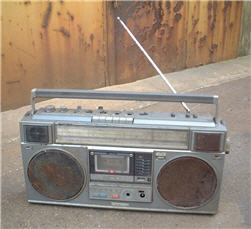However you feel about Snoop Dogg, you have to admit he’s good at producing hit records.
Mr. Snoop is inundated by new artists vying for his attention. A nod from the great Dee-Oh-Dubba-Gee can launch a career. On MTV Cribs, the Doggfather showed us how he vets sample tracks. It’s not what you think — a sound-proof room with a dizzying array of equalizer knobs and $50,000 speakers. No, he takes these tracks and plays them on a little cassette player on the floor.
A cassette player. On the floor. Turned up a little too high so it crackles and distorts during the loud parts.
 Why? Because songs have to sound good even on a cheap car stereo with distractions and tiny speakers and an obnoxious guy in the back spilling you-don’t-want-to-know-what on your velour seat covers.
Why? Because songs have to sound good even on a cheap car stereo with distractions and tiny speakers and an obnoxious guy in the back spilling you-don’t-want-to-know-what on your velour seat covers.
So how do you get a song to sound good in the real world? Music producers suggest that you should use crappy speakers when mixing tracks. If it sounds good on crap, it will sound good anywhere.
This principle applies in an odd way to your company’s pitch. As much as you’d like to believe otherwise, your prospective customers have as many distractions as a group of teenagers listening to the car stereo.
This is true regardless of the medium. Your web page competes with announcements of “You’ve got mail,” instant messages about funny YouTube videos, and the ultimate escape of the “back” button. Your magazine ad competes with a ringing phone and the pull of a more interesting picture on the next page. Your 10-second pitch at parties and tradeshows is dulled by cocktails, the din of the room, and the more interesting story in the adjoining conversation.
These aren’t even “competitors” in the “products, features, services, benefits” sense. It’s competition for attention.
So what can you do about it? A few quick ideas:
- Record your pitch in a noisy environment (a bar, a playground). Play it back; does it still make sense when you can only make out sixty percent of the syllables? Ask victimsfriends to point out what’s engaging and what’s not.
- Lay your printed material on a table and cover up different parts of it with a magazine. Your entire message doesn’t need to shine through, but is it eye-catching enough for someone to notice the fragments, to become interested?
- Use marketing techniques that repeat a message. Distractions and other priorities will come between you and your target most of the time. Repeating often enough (using newsletters, blog, Twitter, Facebook) can push some of your communications through the chaos.
It’s not enough to be compelling when you have 60 uninterrupted, full-attention seconds. Your pitch has to work in the noise.
Do you have more tips for cutting through the noise? Join the conversation.

2 responses to “Standing out from the noise”
This same idea applies to TV ads. For people with Tivo, when you are fast-forwarding through the commercials, occasionally an ad will stand out what makes you go "What?" and you actually stop to watch it. The fragments you see on triple-fast-forward have to be compelling enough to grab your attention.
RIGHT ON!!! BRAVO!!! YES – YES- YES!!!
This truth applies to each and every communication medium – television, radio, newspaper or even -gasp- the web!
I remember the days when graphic artists would place a "disclaimer" on their designs asking visitors to change their monitor settings to be able to "experience" the website.
A great way to "break" through the "noise" is to tightly target your marketing message. Instead of "spraying and praying", tightly target your message to help break through the cacophony of distractions we all live with daily.